June marked the 25th Anniversary of Gramercy! Thank you to our valued investors, trusted business partners and team members without whom this milestone could not have been reached. We are excited for the opportunities we see ahead, and look forward to continuing to deliver upon our mission to have a positive impact on the well-being of our clients, portfolio investments (and their communities) and our team members.
Contents
Market Overview
Macro Review
The ISM surveys firmly point in opposite directions. Recall on Monday that the ISM Manufacturing PMI fell to 46.0 from 47.1 and hit the lowest level since May 2020 when it was 43.5. Meanwhile, the ISM Services Index rose to 53.9 after a surprise decline in May to 50.3. This coincided with an exceptionally strong ADP release. The ISM Services component has now been in expansionary territory for the past six months, while the manufacturing constituent has been in contractionary territory for eight months. The opposite is true in China. The Caixin Manufacturing PMI topped forecasts for a second consecutive month, while the Services PMI had materially underwhelmed versus prior readings. Elsewhere, FOMC minutes did not really tell the market anything new, rather it was a re-confirmation of the hawkish rhetoric that Chair Powell and Fed speakers had reiterated. The FOMC re-confirmed their view of a slowing economy and mild recession baseline, but some participants favored a 25bps hike at the June meeting, which increases the odds of a July hike. The key statement from the minutes was that “all officials expected more rate hikes in 2023” but Chair Powell had previously stated two or more hikes before year-end was the base case. U.S. Treasuries sold-off to post-SVB highs with the ten-year note rising above 4.0% as the two-year rose above 5% in the aftermath of the hot ADP reading. Within the UK, the ten-year gilt rose to its highest level since the mini-budget turmoil in September, but the two-year gilt above 5.50% creates a degree of nervousness as the terminal rate ticked up to 6.5%. Consequently, higher beta assets appeared fragile and nursed losses toward the end of the quiet week, where EMFX was the notable laggard. Other events were focused on the sheer number of PMI releases, where Hungary posted a miserable PMI which fell from 57.1 to 44.2 but was largely ignored, just as Indonesia’s CPI fell to 3.52% and within the 2-4% inflation target band.
EM Credit Update
Emerging market sovereign credit (cash bonds) ended the week down 0.8% with spreads -3 bps tighter, but U.S. Treasuries re-priced 30-40 bps higher in yield. Sovereign outperformers were Pakistan, Zambia and Sri Lanka, while Tunisia, Ghana and Ukraine underperformed. The theme in late June was the pick-up in new issuance. The number of mandated capital market transactions has notably grown, and over the past week we had the first EM’ AT1 mandate since the CS debacle with the Abu Dhabi Islamic Bank.
The Week Ahead
After a buoyant set of U.S. data releases, the attention shifts to U.S. CPI and PPI. To a lesser extent, we will see the Bank of Canada and Reserve Bank of New Zealand rate decisions, followed by UK labor market data. China also has an important set of releases, from CPI to credit growth and export data. The key EM interest rate decisions are due out of Argentina (97%), Israel (4.75%), Peru (7.75%) and South Korea (3.5%). The calendar is instead busier with EM inflation releases from Argentina, Brazil, Colombia, Czech Republic, India, Poland, Romania and Russia. In the background, President Biden will visit Europe for the NATO Summit, while Treasury Secretary Yellen is in China over the weekend. Finally, the Monetary Authority of Singapore is expected to name Deputy Prime Minister (Lawrence Wong) as Central Bank Chair.
Highlights from emerging markets discussed below: Inflation in Turkey has likely bottomed and is set to accelerate for the rest of the year amid timid monetary policy tightening, FX depreciation and tax increases, Sri Lanka’s Central Bank delivers second consecutive rate cut and China PMIs plateauing while People’s Bank of China (PBOC) leadership set for change.
Fixed Income
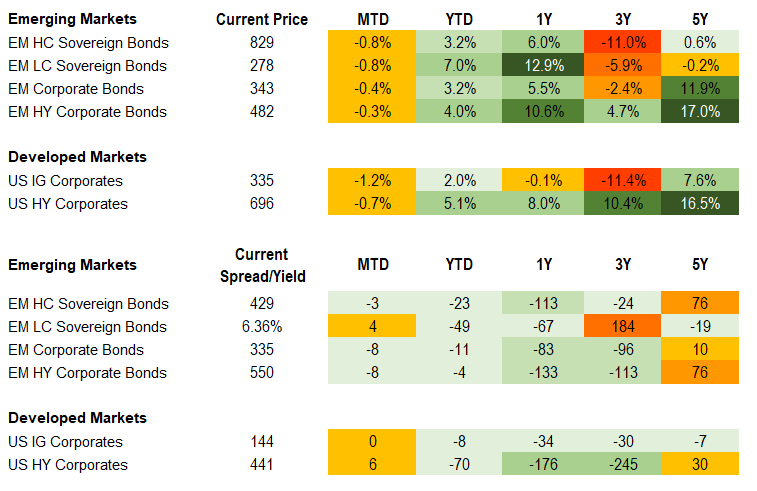
Equities
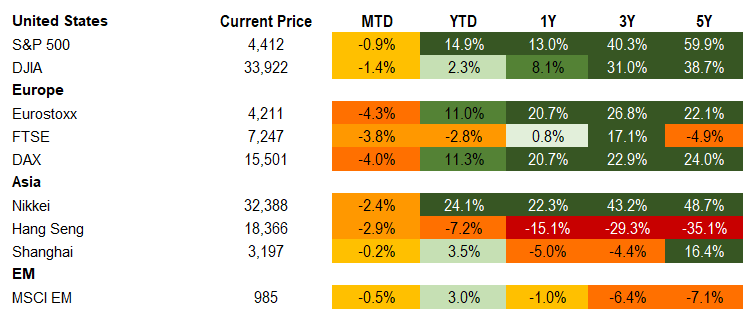
Commodities

Source for data tables: Bloomberg, JPMorgan, Gramercy. EM Fixed Income is represented by the following JPMorgan Indicies: EMBI Global, GBI-EM Global Diversified, CEMBI Broad Diversified and CEMBI Broad High Yield. DM Fixed Income is represented by the JPMorgan JULI Total Return Index and Domestic High Yield Index. Fixed Income, Equity and Commodity data is as of July 7, 2023 (mid-afternoon).
Emerging Markets Weekly Highlights
Inflation in Turkey has likely bottomed and is set to accelerate for the rest of the year amid timid monetary policy tightening, FX depreciation and tax increases
Event: Turkey’s June headline inflation figure came in below market consensus at 38.2% YoY, down from 39.6% YoY the previous month. Meanwhile, this week the authorities announced significant corporate and consumption tax increases in an effort to offset the negative fiscal impact of costly pre-election spending commitments.
Gramercy commentary: We expect annual inflation in Turkey to resume its upward trend the rest of 2023 and end the year in a 50-55% YoY range, undermining any external competitiveness gains that might have materialized from the sizable nominal FX depreciation that took place since President Erdogan’s re-election in June. Despite market-friendly appointments to lead the new economic policy team, the Central Bank of the Republic of Turkey remains politically constrained to deliver the scale of monetary policy normalization needed to restore market confidence and anchor medium-term inflation expectations. Furthermore, recent FX depreciation, tax increases and wage hikes all point to a much more challenging inflation outlook for the rest of the year. Additionally, as we get closer to the highly significant local elections scheduled for March 2024, we expect President Erdogan’s tolerance for the market-friendly economic policies favored by his Minister of Finance Mehmet Simsek to grow lower, especially if GDP growth decelerates meaningfully amid Simsek’s measures. In our view, this is not a macroeconomic management backdrop that is likely to attract material portfolio inflows from foreign investors into the Turkish economy over the near-term despite very favorable technicals. As such, financing the economy’s large external gap will hinge on securing funding by friendly governments in the Gulf region where both Erdogan and Simsek will be heading on official visits in the coming weeks.
Sri Lanka’s Central Bank delivers second consecutive rate cut
Event: The Central Bank of Sri Lanka cut its two main policy rates by 200 bps to 12% and 11%, respectively.
Gramercy commentary: This week’s rate reduction comes on the heels of a 250 bps cut at the previous policy-setting meeting, bringing total monetary easing to 450 bps since June. This is a credit-positive development in the context of supporting the recovery of domestic economic sentiment and, most importantly, GDP growth prospects. The economy appears to have performed better than expected in 2Q and this momentum should continue going forward from the easing of on-shore financing conditions. Additionally, lower interest rates should be supportive for recovery values in the ongoing domestic sovereign bond restructuring, whose proposed parameters were recently unveiled by the authorities. Markets reacted positively to the proposals, perceiving them as useful blueprints for the pending negotiations with bondholders over the restructuring of the government’s external debt obligations. Overall, both the latest economic data and policy actions by the authorities suggest a constructive trajectory from a sovereign credit perspective, which should be supportive for ultimate recovery values. The government targets concluding negotiations with private creditors by September when the first review of Sri Lanka’s IMF program is due.
China PMIs plateauing while People’s Bank of China (PBOC) leadership set for change
Event: June official composite PMI ticked down slightly by 0.6pts to 52.3 led by non-manufacturing while the Caixin composite softened by 3.1pts to 52.5, both still comfortably within expansionary territory. Results were mixed across sub-indices, although new export orders in both manufacturing surveys dropped moderately. This coincides with PBOC’s announced increase in the relending quota by 200bn yuan to 3.3 trillion yuan for SMEs and rural area developments. The press summary of the MPC meeting in 2Q released last week continued to signal the use of policy tools to support the economy. Additionally, Pan Gongsheng, a Deputy Governor of the PBOC, was named the Central Bank’s Communist Party Chief, leading to speculation that he will be the next PBOC Governor, replacing Yi Gang who is set to retire.
Gramercy commentary: Moderately weaker, but generally in line with expectations, PMI data combined with a familiar narrative out of the 2Q MPC meeting, suggests that the authorities remain poised to continue to deliver targeted easing measures in the near-term. If ultimately appointed governor, technocratic Pan Gongsheng, could support policy continuity with an elevated degree of power to streamline or enhance economic support as needed through 2H. At the same time, we think the plateauing economic data in June provides only moderate justification for additional near-term stimulus with the late July Politburo meeting as the next key signpost for substantive measures.
Emerging Markets Technicals
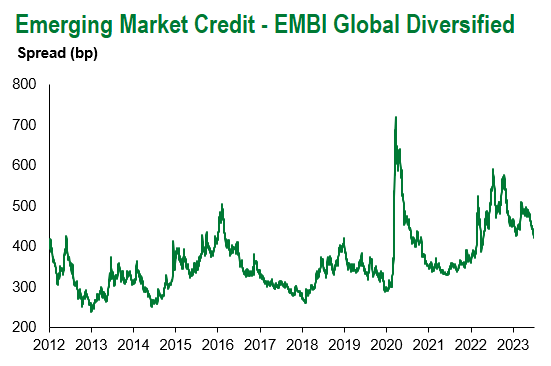
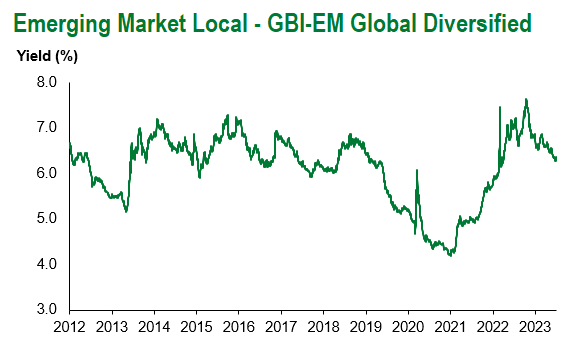
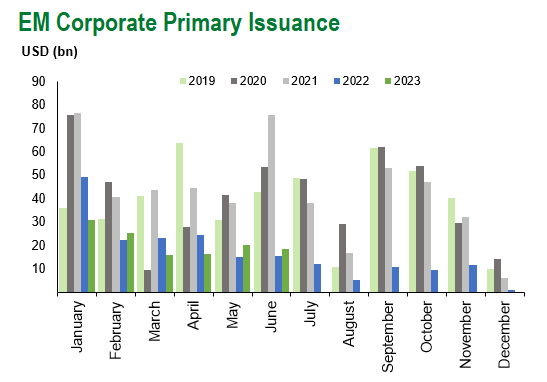
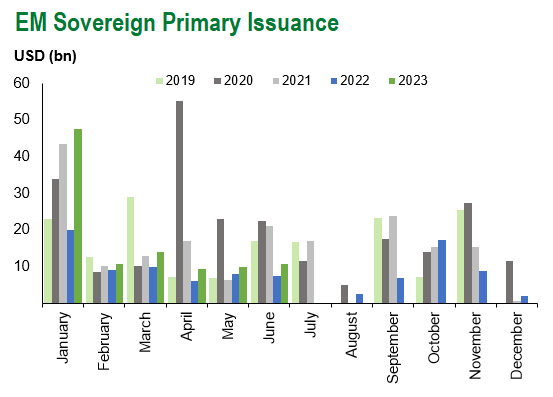
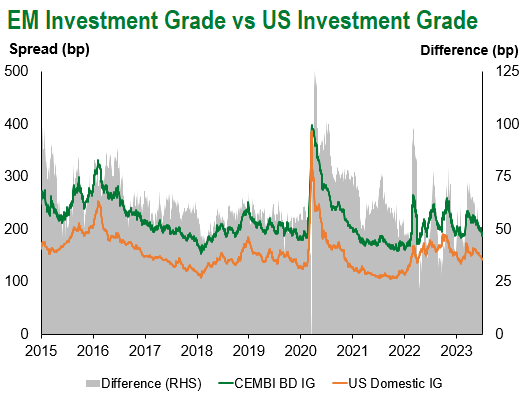
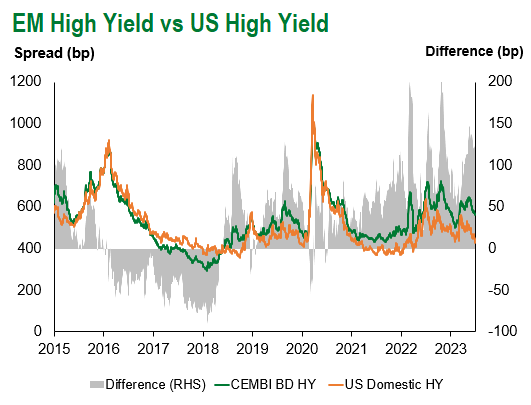
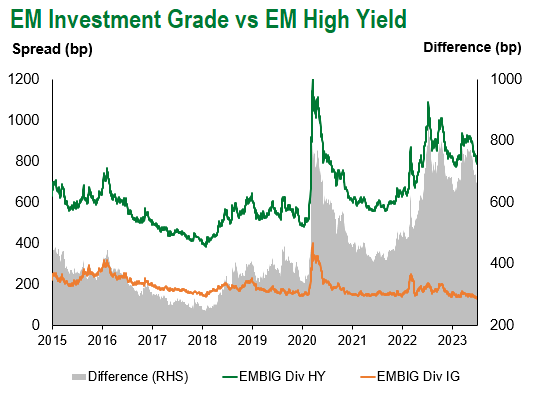
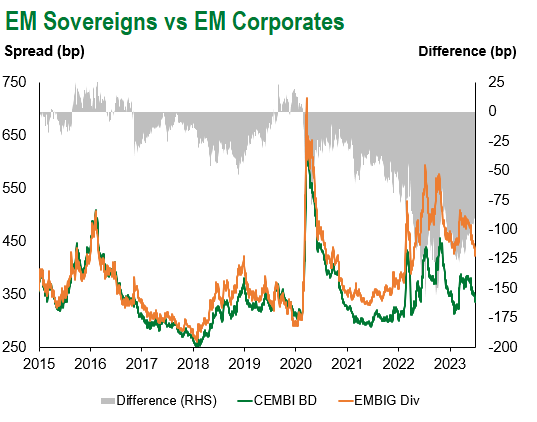
Emerging Markets Flows
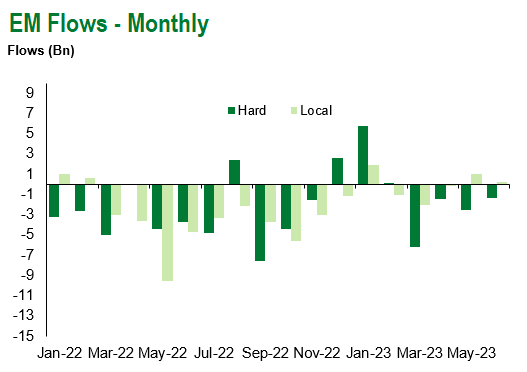
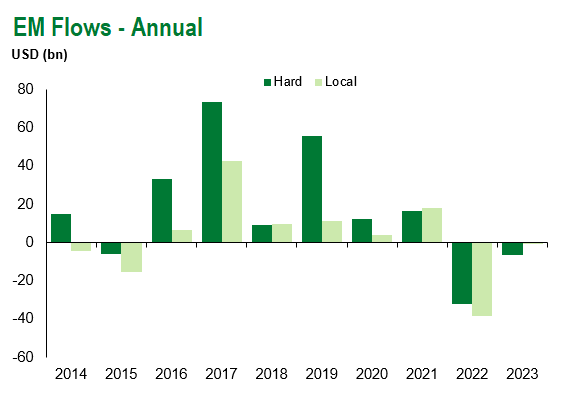
Source for graphs: Bloomberg, JPMorgan, Gramercy. As of July 7, 2023.
For questions, please contact:
Kathryn Exum, CFA ESG, Director, Co-Head of Sovereign Research, [email protected]
Petar Atanasov, Director, Co-Head of Sovereign Research, [email protected]
James Barry, Director, Deputy Portfolio Manager, [email protected]
This document is for informational purposes only. The information presented is not intended to be relied upon as a forecast, research or investment advice, and is not a recommendation, offer or solicitation to buy or sell any securities or to adopt any investment strategy. Gramercy may have current investment positions in the securities or sovereigns mentioned above. The information and opinions contained in this paper are as of the date of initial publication, derived from proprietary and nonproprietary sources deemed by Gramercy to be reliable, are not necessarily all-inclusive and are not guaranteed as to accuracy. This paper may contain “forward-looking” information that is not purely historical in nature. Such information may include, among other things, projections and forecasts. There is no guarantee that any forecasts made will come to pass. Reliance upon information in this paper is at the sole discretion of the reader. You should not rely on this presentation as the basis upon which to make an investment decision. Investment involves risk. There can be no assurance that investment objectives will be achieved. Investors must be prepared to bear the risk of a total loss of their investment. These risks are often heightened for investments in emerging/developing markets or smaller capital markets. International investing involves risks, including risks related to foreign currency, limited liquidity, less government regulation, and the possibility of substantial volatility due to adverse political, economic or other developments. References to any indices are for informational and general comparative purposes only. The performance data of various indices mentioned in this update are updated and released on a periodic basis before finalization. The performance data of various indices presented herein was current as of the date of the presentation. Please refer to data returns of the separate indices if you desire additional or updated information. Indices are unmanaged, and their performance results do not reflect the impact of fees, expenses, or taxes that may be incurred through an investment with Gramercy. Returns for indices assume dividend reinvestment. An investment cannot be made directly in an index. Accordingly, comparing results shown to those of such indices may be of limited use. The information provided herein is neither tax nor legal advice. Investors should speak to their tax professional for specific information regarding their tax situation.
